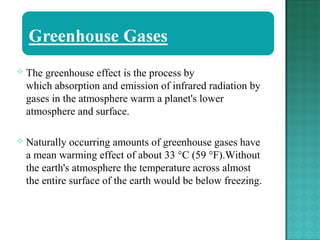Global Warming
- 2. An increase in the average temperature of the earth's atmosphere, especially a sustained increase sufficient to cause climatic change. A gradual increase in the overall temperature of the earth's atmosphere generally attributed to the greenhouse effect caused by increased levels of carbon dioxide, CFCs, and other pollutants. Global warming is the rise in the average temperature of oceans also
- 3. Since the early 20th century, Earth's mean surface temperature has increased by about 0.8 °C (1.4 °F), with about two-thirds of the increase occurring since 1980. Warming of the climate system is unequivocal, and scientists are 95-100% certain that it is primarily caused by increasing concentrations of greenhouse gases produced by human activities such as the burning of fossil fuels and deforestation.
- 5. Sea level rise is accelerating. The planet's temperature is rising. The number of large wildfires is growing. Dangerous heat waves are becoming more common. Extreme storm events are increasing in many areas. More severe droughts are occurring in others. These are having significant and harmful effects on our health, our environment, and our communities.
- 7. Global warming is primarily a problem of too much carbon dioxide (CO2) in the atmosphere—which acts as a blanket, trapping heat and warming the planet. As we burn fossil fuels like coal, oil and natural gas for energy or cut down and burn forests to create pastures and plantations, carbon accumulates and overloads our atmosphere. Certain waste management and agricultural practices aggravate the problem by releasing other potent global warming gases, such as methane and nitrous oxide.
- 9. The greenhouse effect is the process by which absorption and emission of infrared radiation by gases in the atmosphere warm a planet's lower atmosphere and surface. Naturally occurring amounts of greenhouse gases have a mean warming effect of about 33 °C (59 °F).Without the earth's atmosphere the temperature across almost the entire surface of the earth would be below freezing.
- 10. The major greenhouse gases are water vapor, which causes about 36–70% of the greenhouse effect; carbon dioxide (CO2), which causes 9–26%; methane (CH4), which causes 4–9%; and ozone (O3), which causes 3– 7%. Clouds also affect the radiation balance through cloud forcings similar to greenhouse gases. Human activity since the Industrial Revolution has increased the amount of greenhouse gases in the atmosphere, leading to increased radiative forcing from CO2, methane, tropospheric ozone, CFCs and nitrous oxide.
- 12. Reducing the amount of future climate change is called mitigation of climate change. The IPCC defines mitigation as activities that reduce greenhouse gas (GHG) emissions, or enhance the capacity of carbon sinks to absorb GHGs from the atmosphere. Studies indicate substantial potential for future reductions in emissions by a combination of emission-reducing activities such as energy conservation, increased energy efficiency, and satisfying more of society's power demands with renewable energy and nuclear energy sources. Climate mitigation also includes acts to enhance natural sinks, such as reforestation.
- 14. Adaptation to climate change may be planned, either in reaction to or anticipation of climate change, or spontaneous, i.e., without government intervention. A concept related to adaptation is "adaptive capacity", which is the ability of a system (human, natural or managed) to adjust to climate change (including climate variability and extremes) to moderate potential damages, to take advantage of opportunities, or to cope with consequences. Unmitigated climate change (i.e., future climate change without efforts to limit greenhouse gas emissions) would, in the long term, be likely to exceed the capacity of natural, managed and human systems to adapt.















